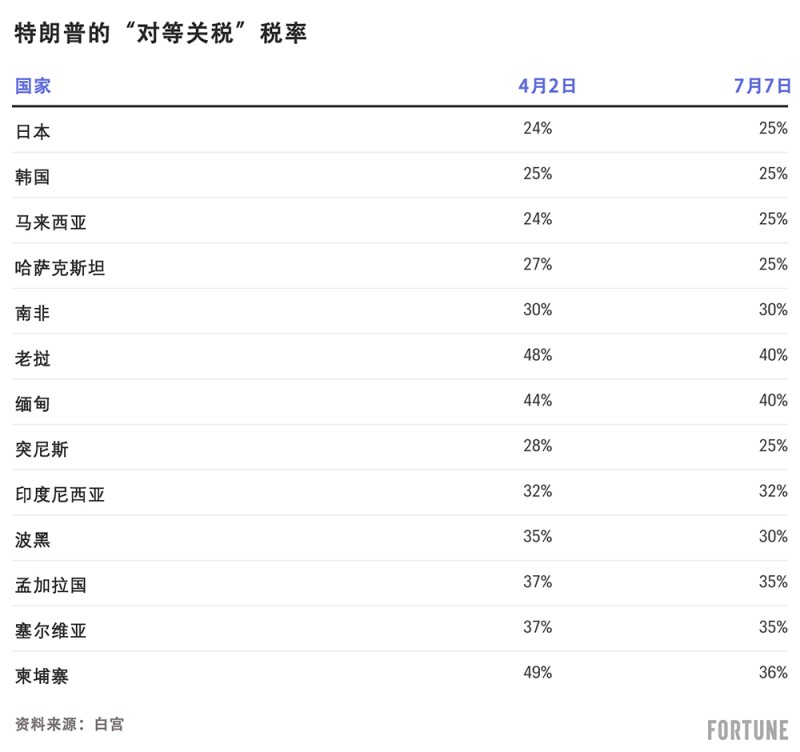
亚洲市场对特朗普政府最新宣布的对部分贸易伙伴的关税税率普遍反应平淡。与此同时,美国总统似乎也将新关税的生效日期推迟至8月1日。
周一,特朗普政府宣布对日本和韩国这两个贸易伙伴统一征收25%的关税,这与特朗普在4月最初威胁实施的税率大致相同。但目前,美国贸易伙伴的新贸易协定谈判期限延长至8月1日,而非先前设定的7月9日最后期限。
日本日经225指数周二收涨0.3%,韩国Kospi指数上涨1.8%。
特朗普在致日本和韩国的信函中指出,被认定为“为逃避更高关税”而转运的商品“将适用更高关税”,但他并未提供具体细节。
此前特朗普政府与越南达成的协议规定,对通过该东南亚国家转运的商品征收40%的关税,但特朗普政府至今尚未明确界定“转运”的具体含义。
美国总统还威胁称,若日本或韩国采取报复性措施,美方将进一步提高关税。
日本首相石破茂与韩国总统李在明周二均乐观地表示,有望在8月1日之前达成双方都能接受的协议。
亚洲其他市场方面,截至美国东部时间凌晨3:30,香港恒生指数上涨1%;印度Nifty 50指数持平;澳大利亚S&P/ASX 200指数亦收于持平。
特朗普周一向媒体表示,这些关税并非“百分之百不可更改”,这意味着在8月1日之前仍有谈判空间。特朗普此次共发出14封信函,其中超过一半发往亚洲经济体。

东南亚
本周一,许多经济体,尤其是东南亚国家,也面临新的关税税率,范围在25%至40%之间。尽管部分国家的税率低于特朗普今年4月初步威胁实施的税率,但相比此前对所有美国进口商品统一征收的10%关税,这仍属于升级举措。
为贸易谈判而设的90天关税加征暂停期原定于本周三到期。目前该期限似乎已延长至8月1日,为谈判提供了更多时间。
这为高度依赖美国这一主要出口市场的东南亚经济体提供了宝贵的喘息之机。
印度尼西亚、泰国、马来西亚和柬埔寨均已公开表示,愿意增加对美国能源和农产品等商品的采购。
马来西亚方面目前正与特朗普政府进行谈判,并在周二表示将继续推进谈判。马来西亚当前适用的关税税率为25%,比“解放日”所提出的税率高出一个百分点。
马来西亚投资、贸易及工业部(Ministry of Investment, Trade, and Industry)在一份声明中表示,该国“致力于继续与美国开展对话,推动达成一份平衡、互利且全面的贸易协议”。
泰国财政部长皮猜·春哈瓦吉拉充满信心地表示,在特朗普宣布36%的关税税率后,泰国有能力通过谈判争取到较低税率。
前一天,皮猜指出,泰国已提出对90%的美国产品下调进口关税,并取消多项商品的关税。他认为美方尚未认真考虑泰国的提议,但持续谈判有望在8月1日前取得积极成果。
印尼经济统筹部长艾尔朗加·哈尔塔托预计将于7月8日抵达华盛顿,与美方代表举行会谈。上周,印尼宣布将与美国签署总额达340亿美元的贸易与投资协议。目前,该国商品将被征收32%的关税,与4月2日所提出的税率相同。
美国周一宣布对柬埔寨征收36%的关税,低于4月时曾威胁实施的49%。这个东南亚国家曾是“解放日”关税最高的国家之一,先前已同意下调对美国商品的关税。(*)
译者:刘进龙
审校:汪皓
亚洲市场对特朗普政府最新宣布的对部分贸易伙伴的关税税率普遍反应平淡。与此同时,美国总统似乎也将新关税的生效日期推迟至8月1日。
周一,特朗普政府宣布对日本和韩国这两个贸易伙伴统一征收25%的关税,这与特朗普在4月最初威胁实施的税率大致相同。但目前,美国贸易伙伴的新贸易协定谈判期限延长至8月1日,而非先前设定的7月9日最后期限。
日本日经225指数周二收涨0.3%,韩国Kospi指数上涨1.8%。
特朗普在致日本和韩国的信函中指出,被认定为“为逃避更高关税”而转运的商品“将适用更高关税”,但他并未提供具体细节。
此前特朗普政府与越南达成的协议规定,对通过该东南亚国家转运的商品征收40%的关税,但特朗普政府至今尚未明确界定“转运”的具体含义。
美国总统还威胁称,若日本或韩国采取报复性措施,美方将进一步提高关税。
日本首相石破茂与韩国总统李在明周二均乐观地表示,有望在8月1日之前达成双方都能接受的协议。
亚洲其他市场方面,截至美国东部时间凌晨3:30,香港恒生指数上涨1%;印度Nifty 50指数持平;澳大利亚S&P/ASX 200指数亦收于持平。
特朗普周一向媒体表示,这些关税并非“百分之百不可更改”,这意味着在8月1日之前仍有谈判空间。特朗普此次共发出14封信函,其中超过一半发往亚洲经济体。
东南亚
本周一,许多经济体,尤其是东南亚国家,也面临新的关税税率,范围在25%至40%之间。尽管部分国家的税率低于特朗普今年4月初步威胁实施的税率,但相比此前对所有美国进口商品统一征收的10%关税,这仍属于升级举措。
为贸易谈判而设的90天关税加征暂停期原定于本周三到期。目前该期限似乎已延长至8月1日,为谈判提供了更多时间。
这为高度依赖美国这一主要出口市场的东南亚经济体提供了宝贵的喘息之机。
印度尼西亚、泰国、马来西亚和柬埔寨均已公开表示,愿意增加对美国能源和农产品等商品的采购。
马来西亚方面目前正与特朗普政府进行谈判,并在周二表示将继续推进谈判。马来西亚当前适用的关税税率为25%,比“解放日”所提出的税率高出一个百分点。
马来西亚投资、贸易及工业部(Ministry of Investment, Trade, and Industry)在一份声明中表示,该国“致力于继续与美国开展对话,推动达成一份平衡、互利且全面的贸易协议”。
泰国财政部长皮猜·春哈瓦吉拉充满信心地表示,在特朗普宣布36%的关税税率后,泰国有能力通过谈判争取到较低税率。
前一天,皮猜指出,泰国已提出对90%的美国产品下调进口关税,并取消多项商品的关税。他认为美方尚未认真考虑泰国的提议,但持续谈判有望在8月1日前取得积极成果。
印尼经济统筹部长艾尔朗加·哈尔塔托预计将于7月8日抵达华盛顿,与美方代表举行会谈。上周,印尼宣布将与美国签署总额达340亿美元的贸易与投资协议。目前,该国商品将被征收32%的关税,与4月2日所提出的税率相同。
美国周一宣布对柬埔寨征收36%的关税,低于4月时曾威胁实施的49%。这个东南亚国家曾是“解放日”关税最高的国家之一,先前已同意下调对美国商品的关税。(*)
译者:刘进龙
审校:汪皓
Asian markets largely shrugged off the Trump administration’s latest announcement of tariff rates on some of its trading partners, as the U.S. president also seemingly pushed the start date for new taxes to Aug. 1.
On Monday, Trump’s White House unveiled flat 25% tariffs on Japan and South Korea, two of the U.S’s trading partners. Those are at roughly the same level that Trump originally threatened back in April. But now, U.S. trading partners have until Aug. 1 to negotiate new trade deals, instead of a previously imposed July 9 deadline.
Japan’s Nikkei 225 closed 0.3% higher on Tuesday. South Korea’s Kospi rose by 1.8%.
In his letters to Japan and South Korea, Trump noted that goods deemed to be transshipped to “evade a higher tariff will be subject to that higher tariff,” though did not give specifics.
A previously announced deal with Vietnam imposed a 40% tariff on goods transshipped through the Southeast Asian country, but the Trump administration has yet to share how it understands “transshipment” as a concept.
The U.S. president also threatened to hike tariffs further if either Japan or South Korea retaliates with their own measures.
Both Japanese Prime Minister Shigeru Ishiba and South Korean President Lee Jae Myung expressed optimism on Tuesday that they could find a mutually agreeable arrangement before Aug. 1.
Elsewhere in Asia, Hong Kong’s Hang Seng Index is up by 1% as of 3:30 a.m. Eastern Time. India’s Nifty 50 is flat. Australia’s S&P/ASX 200 also closed flat.
Trump told reporters on Monday that the tariffs weren’t “100% firm,” meaning there was still room for negotiation before Aug. 1. A total of 14 letters were sent out, and more than half were sent to economies in Asia.
Southeast Asia
Many other economies, particularly in Southeast Asia, were also slapped with new tariff rates on Monday, ranging from 25% to 40%. While some of these rates were lower than what was threatened back in April, they are still an escalation from the flat 10% tariff on all U.S. imports.
The 90-day tariff pause for trade negotiations was originally meant to expire on Wednesday. That deadline appears to have been extended to Aug. 1, allowing more time for negotiations.
And that could be much appreciated breathing room for Southeast Asian economies, which rely on the U.S. as a major export market.
Indonesia, Thailand, Malaysia, and Cambodia have all publicly offered to buy more U.S. products, like energy or agricultural goods.
Malaysia, already in negotiations with Washington, said Tuesday that it will continue negotiations with the U.S. The country is now getting a 25% tariff, one percentage point higher than what was proposed on “Liberation Day.”
Malaysia’s Ministry of Investment, Trade, and Industry said in a statement that the country is “committed to continuing engagement with the U.S. towards a balanced, mutually beneficial, and comprehensive trade agreement.”
In Thailand, Finance Minister Pichai Chunhavajira expressed confidence that the country could negotiate a lower tariff rate following the 36% announced by Trump.
The day before, Pichai noted Thailand had offered to reduce import taxes on 90% of U.S. products, and to eliminate taxes on many items. He believed the U.S. has yet to consider Thailand’s proposal, and that continued talks will lead to a positive outcome by Aug. 1.
Indonesia’s Coordinating Minister for Economic Affairs, Airlangga Hartarto, is expected to arrive in Washington on July 8 to meet with U.S. representatives. Last week, Indonesia said it was committing $34 billion in trade and investment agreements with the U.S. The Southeast Asian country will now see a 32% tariff rate on its products, the same rate as what was proposed on April 2.
Cambodia got a 36% tariff on Monday, lower than the 49% originally threatened in April. The Southeast Asian country, which got one of the highest Liberation Day tariff rates, has previously agreed to cut tariffs on U.S. goods.

